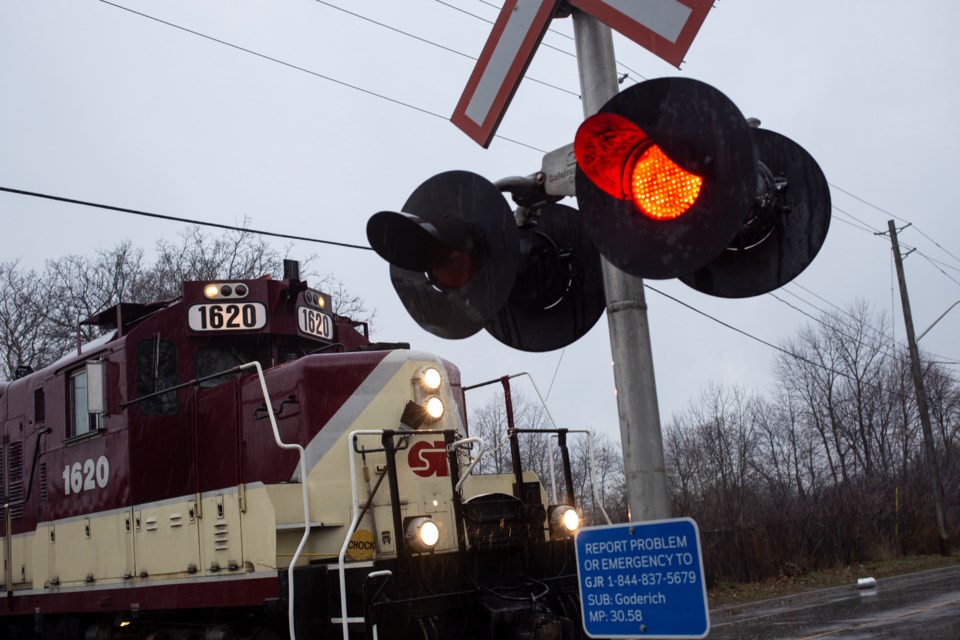Many Guelphites may be unaware that many of the train tracks that weave through much of the city are actually owned by the City of Guelph, is a profitable asset and supports many local industries.
The general manager of the Guelph Junction Railway (GJR) says some day there may even be a possibility the line could support a passenger rail system.
GJR is a short-line railway which services many businesses in Guelph. On any given day the rail cars hauled by GJR could carry wood, corn, malt, plastic pellets or any number of materials to be used as-is or transformed into all new products.
The GJR has been city-owned since it began operation in 1888, but was operated by Canadian Pacific Railway (CPR) until 1998, when the company chose not to renew its long-term lease with the city.
Since then, the 38 kilometres of track has been operated by Ontario Southland Railway, while remaining city-owned.
The short-line railway connects to CPR near Campbellville and to the Canadian National Railway (CNR) near Edinburgh Road South and Speedvale Avenue.
Les Petroczi has been the general manager of GJR for the last six years. He told GuelphToday that many people in Guelph are not aware the city owns a railway, let alone a profitable one.
“I am really proud of what I am doing for the city,” said Petroczi. “The railway is a success, more than it’s ever been.”
Petroczi is one of only two actual GJR employees working for the City of Guelph, with much of the work — from operating to maintenance and new construction — being done by contractors.
Whenever possible, Petroczi said he tries to use local workers and local companies for those contracts.
He notes the number of jobs in Guelph that the GJR supports can’t really be measured, with raw materials coming in to the city, being made into something else and the spinoff jobs that come with the process — even the truck drivers who drive away with the final products.
“The number of people the railway employs is not just railway-related, it goes so much beyond that,” said Petroczi. “By the time that product ends up on your table or on your shelf, in your garage — it’s crazy.”
Helen Loftin agrees. She is the General Manager of Business Development and Enterprise for the city.
Loftin said the GJR is an economic good news story for the City of Guelph.
In the last four years, GJR has experienced a significant increase in revenues from freight, with average net income of $3.6 million, compared to $2 million from 2014 and prior.
As the GJR’s sole shareholder, the City of Guelph was paid a dividend of $80,000 last year.
Remaining revenues generated by the railway are reinvested by way of capital improvements.
This year alone, a total of nine level crossings have been completely overhauled, many have been raised to minimize impacts on motor vehicles and some safety improvements have been added, like larger LED signal lights.
Those 12-inch LED signal lights have better visibility and use less electricity than the previously-used eight-inch incandescent version.
“A burned-out bulb can mean an accident,” said Petroczi of the previously-used incandescent lights.
Many of the bells at crossings have also been replaced with electronic ones, eliminating a long-standing problem with the older mechanical ones.
“The bees can’t make their hives in them,” said Petroczi.
In addition to improvements to existing infrastructure, GJR has also been planning for the future with additional tracks being placed in recent years for its customers, like PDI, as well as ongoing improvements to drainage and other track infrastructure.
“We are putting our revenues back into our railway and we are making things safer,” said Petroczi.
Additionally, a new Arkell transloading area was opened last month, with a siding allowing for loading or offloading of goods and materials.
“It could be corn, it could be fertilizer or salt. Right now we are using it for plastic powder,” said Petroczi.
If the right customer comes along, Petroczi said a similar site in nearby Corwhin could also be built within the next two years.
Currently, the Corwhin site is being used for temporary storage of old wooden railway ties, which are being sent away for disposal. Petroczi said there was a time when the ties would be left behind in a pile when track upgrades were made, but to date he has had about 20,000 of them removed.
Although there are no current plans in the works, Petroczi said the improvements GJR is making to its existing infrastructure may some day make the railway viable for adding passenger rail service, like the recently opened Kitchener-Waterloo LRT.
“We would do it a little different than they did,” said Petroczi.
In his previous 37-year career at PNR Railworks, Petroczi did work for many major passenger rail services across Canada.
“I learned what works well and what doesn’t work so well,” he said.
Improvements would have to be made to signalling and passing tracks added to allow for the freight and passenger rail to coexist on the same tracks, but Petroczi believes if the will is there, it could be done in the future.
“It’s an opportunity we should never give up,” he said. “We’re planning for the future. I’m big on that.”.
GJR is sometimes confused with the CNR-owned tracks in the city. A map on the railway's web page clarifies which are owned by GJR and which are owned by CNR and Metrolinx.
One kind of goods Petroczi refuses to allow in the city centre is dangerous materials.
He said one buisness that planned to set up shop in Guelph decided against it after Petroczi made it clear the dangerous material would not be allowed on GJR tracks passing through downtown.
“I am not taking that product through the city, I’m not doing that,” said Petroczi. “That’s a decision I made on behalf of the city. I didn’t want the business that bad.”
